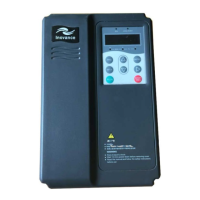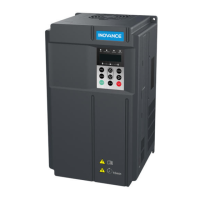8.2 Common Fault and Resolution
During the inverter using process, the following faults may occur. Please conduct simple fault
analysis by referring to the methods below:
Table8-1 Common Fault and Resolution
No. Fault Phenomenon Possible Cause Solution
1
No display upon
power-on
The inverter has no input 1.
power supply.
8-core bus connecting with 2.
the drive board and control
bard is in poor contact.
The internal parts of the inverter
are damaged.
Check the input power 1.
supply.
Plug/unplug the 8-core 2.
bus once again.
Consult the manufacturer.3.
2
HC is displayed upon
power-on
4-core bus connecting with 1.
the drive board and control
bard is in poor contact.
Other parts of the inverter are
damaged.
Plug/unplug the 4-core 1.
bus once again.
Consult the manufacturer.
3
“ERR23” alarm
is displayed upon
power-on.
The motor or the output 1.
line is short circuited to the
earth.
The inverter is damaged.
Measure the insulation of 1.
the motor and output line
with magneto-ohmmeter.
Consult the manufacturer.
4
The inverter displays
n o r m a l l y u p o n
power-on, but “HC”
is displ ayed upo n
running and stops
immediately.
The fan is either damaged or
blocked.
Replace the fan.
5
E R R 1 4 ( m o d u l e
over heat) fault is
frequently reported.
The carrier frequency is set 1.
too high.
The fan is damaged or the 2.
air duct is blocked.
The i nt ernal p ar ts (th er ma l
coupler or others) of the inverter
are damaged.
R e d u c e t h e c a r r i e r 1.
frequency (F0-15).
Replace the fan and clear 2.
the air duct.
Consult the manufacturer.
6
The motor does not
rotate upon Inverter
running.
T h e m o t o r i s e i t h e r 1.
damaged or blocked.
The parameters are set 2.
improperly (mainly Group
F1 motor parameters).
Rep la c e t he mot or or 1.
remove the mechanical
fault.
Check and reset Group F1 2.
parameters.

